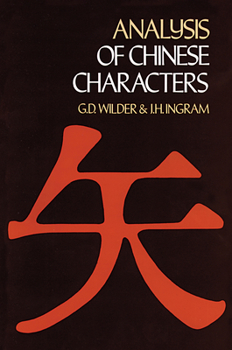Analysis of Chinese Characters
Select Format
Select Condition 
Book Overview
Far and away the most useful analysis of characters for both beginning and intermediate students. 1,000 most important characters are analyzed according to primitives, phonetics, and historical development. Traditional method offers mnemonic aid to students of Chinese and Japanese languages.
Format:Paperback
Language:English
ISBN:0486230457
ISBN13:9780486230450
Release Date:November 2011
Publisher:Dover Publications
Length:384 Pages
Weight:1.10 lbs.
Dimensions:0.8" x 6.1" x 9.4"
Customer Reviews
5 ratings
A first step in understanding chinese ideograms
Published by Thriftbooks.com User , 16 years ago
This short book will help you to understand that chinese writing is not as mysterious as it seems at first. Each complex character is built from simpler ideograms, and the arrangement tells the story. A nice touch is that all chinese characters, by a calligrapher, are printed in bright red (similar to the seal red) against the black text. The bichrome printing is refreshing. Of course, not enough to learn chinese, but enough to be tempted to.
This book is very useful and interesting
Published by Thriftbooks.com User , 22 years ago
This book is criticized by some high brow scholars because it has some etymological errors, however the information it provides for every character (some 1400 in this book) is very helpful for learning them, it also gives for most of them the old seal form that is highly informative. To learn above 4000+ is a interesting, fascinating but difficult task, and this book is a great help for building memory holds. It uses a old style romanization but is easy to get hold of it in some minutes, it has a very useful alphabetic index and a stroke index. I would recommend it as a extra help for those using the Heising method.
I concur with the previous reviews...
Published by Thriftbooks.com User , 24 years ago
I had been looking for a text which would allow me to speed my process of learning Chinese. Because I am at an intermediate level, this text provided me with an historical and logical foundation for Chinese characters which I feel is a better method for learning than the raw memorization taught in most texts and courses.Although the Wade-Giles Romanization system has become a dead system (for good reason), conversion into the more familiar PinYin isn't too bad with a little practice. If you're going to learn Chinese, for example, a few hours learning the intricacies between Wade-Giles, PinYin and the Yale Romanization systems shouldn't be any deterrant.Zakarius
Spectacular book
Published by Thriftbooks.com User , 25 years ago
The book's only flaw is its use of a dated romanization, Wade-Giles, instead of pinyin. Otherwise it is a fascinating study of 1000 Chinese characters. The characters' parts are examined thoroughly and then we are shown how the joined pieces make up both the sound and meaning of the original character. I don't understand how such an interesting part of learning and understanding Chinese has been neglected. If you are learning Chinese, do not covet this book. Buy it! Now!
Dated, but very useful
Published by Thriftbooks.com User , 25 years ago
I have the 1974 printing, which is an unabridged reprinting of the 1934 second edition. Since the number of pages is the same as the current edition, I assume there are no changes.The analysis is of traditional, rather than simplified characters, and the romanization system used is not Pinyin, but the older Wade-Giles. This makes the book of somewhat limited use to those trying to understand Chinese characters as they are written in the PRC, but it is still a very interesting work. It meets a need similar to that of Michael Rowley's Kanji Pict-O-Graphix, but for Chinese, rather than Japanese. (Rowley's book, however, is more accessable.)




